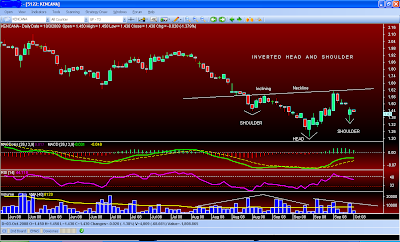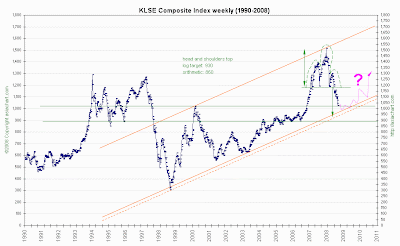
Composite Index Daily Technical Analysis 30/10/2008 by Zhuge Liang
The KLCI ended 2.9% higher on Thursday, in line with the Asian markets as triggered by news of the US Federal Reserve cutting key interest rate. As indicated by A, the KLCI is now testing the T2 line, which is also at the similar level of the Bollinger Middle Band dynamic resistance. Therefore, this is likely to be a stronger resistance. Support for the KLCI is at 800 mark while the resistance is still at 887 Fibonacci Retracement.
As shown on the chart above, the Bollinger Bands Width contracted 10%, suggesting a consolidation or technical rebound signal for the KLCI. Generally, the first target for the KLCI would be the Bollinger Middle Band. If the KLCI should break above the Bollinger Middle Band, it would improve the immediate outlook for the KLCI.
As indicated by B, total market volume increased 49.5%, which is a 7 month new high level. The increased of volume was associated with the rising of price, thus a positive signal suggesting some increased of buying interests in the market. Therefore, if the KLCI should continue to rebound with volume staying above the 40-day VMA level, the market sentiment is likely to improve.
As circled at C, the Stochastic breaks above 30% level, thus a signal suggesting a beginning of a technical rebound. If the Stochastic should continue rising, the rebound is expected to continue. If the Stochastic should break above 70% level, it would be a short term bullish signal for the KLCI.
综合指数 2008年 10月 30日 by Zhuge Liang
在美国联邦储备局减息的影响下,亚太股市纷纷上扬,这也带动综合指数上扬2.9%。如图中箭头A所示,综指接下来将面对T2趋势线的阻力,这也将是布林中频带(Bollinger Middle Band)的动态阻力水平,所以阻力预料将倍增。
综指当前的支持水平仍然是800点的胜图自动费氏线,这也是一个心理支持水平,阻力水平则是887点的胜图自动费氏线。
如图所示,布林频带(Bollinger Band)收窄10%,这表示综指一反之前的跌势,而出现了技术回弹的格局。通常综指将有望回弹至布林中频带这水平,而布林中频带将成为综指的动态阻力线。若综指能成功的上扬突破布林中频带的话,那综指就将有望从技术反弹转为上扬的趋势。
如图中箭头B所示,马股的成交量增长49.5%,创下7个月来的新高水平,这表示整体市场交投继续的热炽。无论如何,当综指出现上扬或转强时,成交量能达到40天成交量平均值(VMA)都是对综指有正面的影响。
如图中C圈所示,随机指标(Stochastic)上扬突破30%,这确认综指短期出现技术反弹。通常若随机指标能继续的攀升,那综指的技术反弹将有望维持下去,而当随机指标上扬突破70%的话,那综指将出现短期上扬的涨势,直到随机指标反过来跌破70%为止。
The KLCI ended 2.9% higher on Thursday, in line with the Asian markets as triggered by news of the US Federal Reserve cutting key interest rate. As indicated by A, the KLCI is now testing the T2 line, which is also at the similar level of the Bollinger Middle Band dynamic resistance. Therefore, this is likely to be a stronger resistance. Support for the KLCI is at 800 mark while the resistance is still at 887 Fibonacci Retracement.
As shown on the chart above, the Bollinger Bands Width contracted 10%, suggesting a consolidation or technical rebound signal for the KLCI. Generally, the first target for the KLCI would be the Bollinger Middle Band. If the KLCI should break above the Bollinger Middle Band, it would improve the immediate outlook for the KLCI.
As indicated by B, total market volume increased 49.5%, which is a 7 month new high level. The increased of volume was associated with the rising of price, thus a positive signal suggesting some increased of buying interests in the market. Therefore, if the KLCI should continue to rebound with volume staying above the 40-day VMA level, the market sentiment is likely to improve.
As circled at C, the Stochastic breaks above 30% level, thus a signal suggesting a beginning of a technical rebound. If the Stochastic should continue rising, the rebound is expected to continue. If the Stochastic should break above 70% level, it would be a short term bullish signal for the KLCI.
综合指数 2008年 10月 30日 by Zhuge Liang
在美国联邦储备局减息的影响下,亚太股市纷纷上扬,这也带动综合指数上扬2.9%。如图中箭头A所示,综指接下来将面对T2趋势线的阻力,这也将是布林中频带(Bollinger Middle Band)的动态阻力水平,所以阻力预料将倍增。
综指当前的支持水平仍然是800点的胜图自动费氏线,这也是一个心理支持水平,阻力水平则是887点的胜图自动费氏线。
如图所示,布林频带(Bollinger Band)收窄10%,这表示综指一反之前的跌势,而出现了技术回弹的格局。通常综指将有望回弹至布林中频带这水平,而布林中频带将成为综指的动态阻力线。若综指能成功的上扬突破布林中频带的话,那综指就将有望从技术反弹转为上扬的趋势。
如图中箭头B所示,马股的成交量增长49.5%,创下7个月来的新高水平,这表示整体市场交投继续的热炽。无论如何,当综指出现上扬或转强时,成交量能达到40天成交量平均值(VMA)都是对综指有正面的影响。
如图中C圈所示,随机指标(Stochastic)上扬突破30%,这确认综指短期出现技术反弹。通常若随机指标能继续的攀升,那综指的技术反弹将有望维持下去,而当随机指标上扬突破70%的话,那综指将出现短期上扬的涨势,直到随机指标反过来跌破70%为止。





 28th October: Approached, breached & rebounded off arithmetic target of 830 amid strong support.
28th October: Approached, breached & rebounded off arithmetic target of 830 amid strong support. 






ct08.png)






























